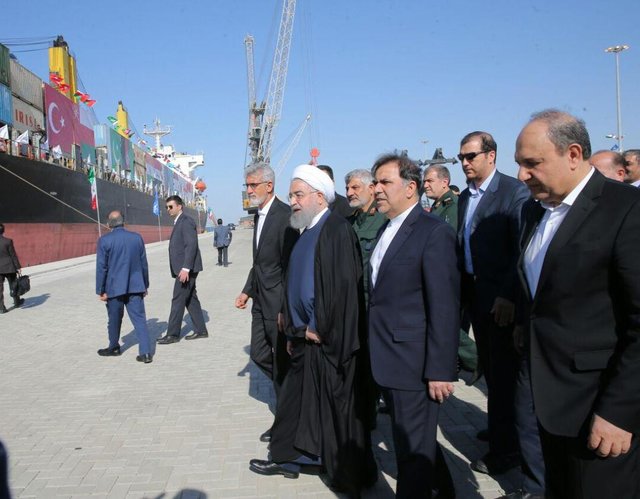Chabahar Port’s Phase I inaugurated by Iran’s President Hassan Rouhani on December 3 marks an important milestone in India-Iran relations as well as Afghanistan-India determination to look for a viable transit corridor to landlocked Afghanistan, bypassing Pakistan.
Located in the Sea of Oman along the Makran coast, in the Iranian province of Sistan-Baluchestan, just 75 km from the China-built and operated Gwadar Port in Balochistan Province of Pakistan, Chabahar is 480 nautical miles from Kandla Port, and about 900 km from Adani Group’s Mundra Port in Gujarat.
It came into the reckoning as a gateway port in the 1970s, reads an article published in the Indian newspaper The Hindu Business Line. The full text follows:
Chabahar acquired importance when, during the Iran-Iraq war, ships were reluctant to enter the Strait of Hormuz.
While Bandar Abbas was being used to send cargo through the emerging North-South Corridor to Europe, Chabahar was envisaged to deal with the eastern axis that would carry goods to Afghanistan and Central Asia.
Although it involves the use of a land-cum-sea route to trade with Afghanistan against the much shorter land corridor through Pakistan, Chabahar provides linkage via an Iranian-built road to the western Afghan border connected to the Zaranj-Delaram Road India has built in Afghanistan.
Connecting Chabahar with the North-South Corridor initiative would also enable Indian goods to sail to the Iranian port, then go by rail to Mashhad on the northern border into Azerbaijan and southern Russia, dock at Astrakhan, thereafter move up the Volga River into the Russian heartland.
Chabahar is billed as India’s gateway to Afghanistan and beyond, including Central Asia, Russia and further to Europe. It would also provide India direct access to its Farkhor air base in Tajikistan.
Fortunate Foothold
India has an interest in gaining a foothold in the free trade zone being developed around the port: In addition to a urea plant, other energy-intensive industries can also be set up in the zone. In fact, National Aluminum Company has signed a memorandum of understanding to locate an aluminum plant in Chabahar. Proposals for Indian investments in upstream oil and gas exploration have been discussed by Petroleum Minister Dharmendra Pradhan during his visits to Tehran.
The Afghanistan-bound maiden wheat shipment flagged off by the foreign ministers—Sushma Swaraj of India, Salahuddin Rabbani of Afghanistan and Mohammad Javad Zarif of Iran—through a joint video conference on October 29 signified a major push for India’s Afghan outreach, bypassing Pakistan. The first of the six consignments of a total of 1.1 million tons of wheat committed by India for Afghanistan that left Kandla Port would be transshipped overland through Chabahar.
The port project follows the trilateral agreement on establishment of an international transport and transit corridor signed in Tehran by Indian Prime Minister Narendra Modi along with Afghanistan’s President Mohammad Ashraf Ghani and Iran’s President Hassan Rouhani in May 2016.
A bilateral India-Iran agreement aimed at India refurbishing one of the berths at Shahid Beheshti Port (one of the two port segments at Chabahar, the other being Shahid Kalantri) and reconstructing a 600-meter-long container handling facility at the same port segment.
Beyond Bottlenecks
India also contemplated connecting Chabahar Port to the mineral-rich Hajigak region in Afghanistan, 130 km west of Kabul in Bamiyan Province, which would entail the construction of a 900-km rail line that would enable Afghanistan to access the sea, thus reducing its dependence on Pakistan.
Frequent closure of borders by Pakistan created bottlenecks in trade transit. In view of Pakistan denying access through its territory, India and Afghanistan launched an air freight corridor in June this year.
The current India-Afghanistan trade, which has lately increased to $700 million annually, is aimed at reaching $10 billion in the future.
As the opening of Chabahar Port and India’s role in its management calls for celebration, it may well be an opportune occasion for India to engage with its neighbors with vigor in its “Neighborhood First” policy. It also needs to introspect on why India is moving at bullock-cart speed compared to China that is zipping ahead like a Formula One racing car.
India does not have deep pockets; what is inexcusable is its bureaucratic sloth and smugness. As the government machinery moves at a slovenly pace, India doesn’t deliver promptly on promises made even at the highest levels.


